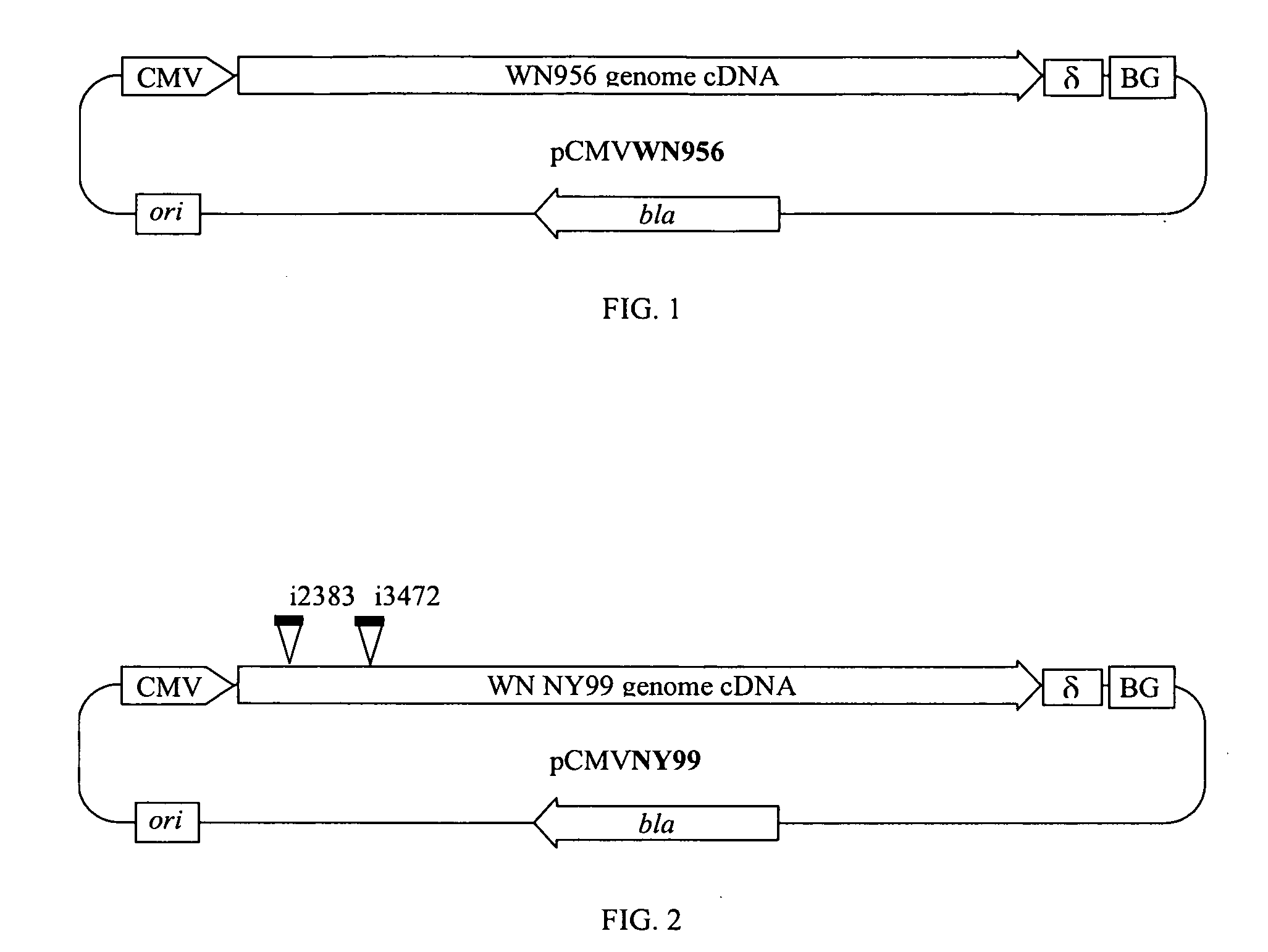Chimeric west nile viruses and uses thereof
- Summary
- Abstract
- Description
- Claims
- Application Information
AI Technical Summary
Benefits of technology
Problems solved by technology
Method used
Image
Examples
example 1
Construction of pCMVWN956
[0056] Isolate WN956D117B3 (earlier also referred to as WN-Nigeria or WN-Wengler (Berthet et al., 1997; Lanciotti et al., 1999)) is a descendant of the WN virus prototype B956 (Smithburn et al., 1940), and is one of the first flaviviruses for which the complete nucleotide sequence has been determined (Castle et al., 1986; Castle et al., 1985; Wengler et al., 1985; GenBank #M12294). Archival RNA isolated from WN956D117B3 was used to rescue the virus, and to prepare the cDNA fragments which were used to assemble the WN infectious clone designated as pSP6WN / Xba, deposited at ATCC Deposit No. ______ and described in co-pending patent application Ser. No. 11 / 065,783, which is incorporated by reference. For simplicity, the pSP6WN / Xba infectious clone shall be referred to herein as pSP6WN956 to better reflect its relationship to the parent virus strain WN956D117B3. The virus recovered from this infectious clone is deposited at ATCC Deposit No. ______, which is inc...
example 2
Construction of pCMVNY99
[0059] In this example, an infectious clone of the WN NY99 strain was assembled using the WN viral isolate 385-99 (Xiao et al., 2001), reported as GenBank #AY842931, which is incorporated by reference. The WN viral isolate 385-99 of the NY99 strain at Vero passage 1 was kindly provided by R. Tesh (Galveston, Tex.) and the working stock (8.8×107 pfu / ml) was prepared by additional passage in Vero cells. There is one silent A→G substitution at position 630 in the nucleotide sequence of the reported WN viral isolate 385-99 genome (GenBank #AY842931) as compared to the sequence found by the present inventors on the passaged virus, which has been reported (GenBank #DQ211652, which is incorporated by reference).
[0060] To construct the infectious DNA plasmid encoding the NY99 strain, a similar Cla I-Bgl II CMV-5′UTR joint fragment was created using WN viral isolate 385-99 cDNA, that was used to assemble a CMV-driven subgenomic replicon construct lacking genes C, pr...
example 3
Preparation of Chimeric Constructs
[0066] In this example, the pCMVWN956 and pCMVNY99 constructs from Examples 1 and 2 were used to create plasmids carrying reciprocal exchanges of the structural protein genes of two viruses as shown in FIG. 3. Three chimeric constructs were prepared. The pCMV[CprMENY99]WN956 chimera carries genes of all NY99 structural proteins (C, prM, and E) instead of those of WN956. In the pCMV[prMENY99]WN956 chimera, only the prM-E region of NY99 (not including its prM signal sequence) from position 466 to 2405 was used to replace the corresponding region in the pCMVWN956 construct. The last chimeric construct pCMV[CprMEWN956]NY99 was created by transferring the Bgl II-Mfe I fragment coding for CprME of WN956 into pCMVNY99.
[0067] More specifically, reciprocal exchanges of the C-prM-E genes between pCMVWN956 and pCMVNY99 were done by exchange of the corresponding Bgl II-Mfe I fragments (from position 89, 8 nucleotides upstream from the beginning of NY99 and WN...
PUM
| Property | Measurement | Unit |
|---|---|---|
| Fraction | aaaaa | aaaaa |
| Fraction | aaaaa | aaaaa |
| Time | aaaaa | aaaaa |
Abstract
Description
Claims
Application Information
 Login to View More
Login to View More - R&D
- Intellectual Property
- Life Sciences
- Materials
- Tech Scout
- Unparalleled Data Quality
- Higher Quality Content
- 60% Fewer Hallucinations
Browse by: Latest US Patents, China's latest patents, Technical Efficacy Thesaurus, Application Domain, Technology Topic, Popular Technical Reports.
© 2025 PatSnap. All rights reserved.Legal|Privacy policy|Modern Slavery Act Transparency Statement|Sitemap|About US| Contact US: help@patsnap.com



